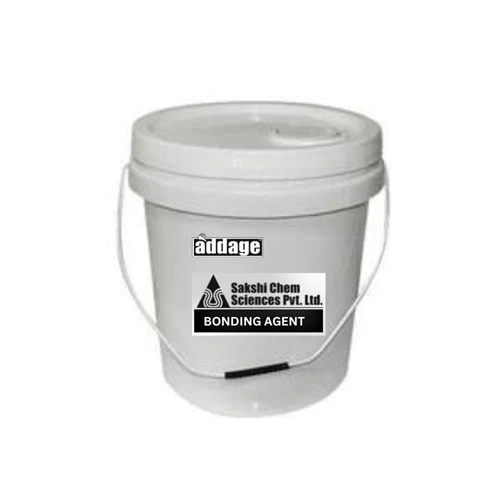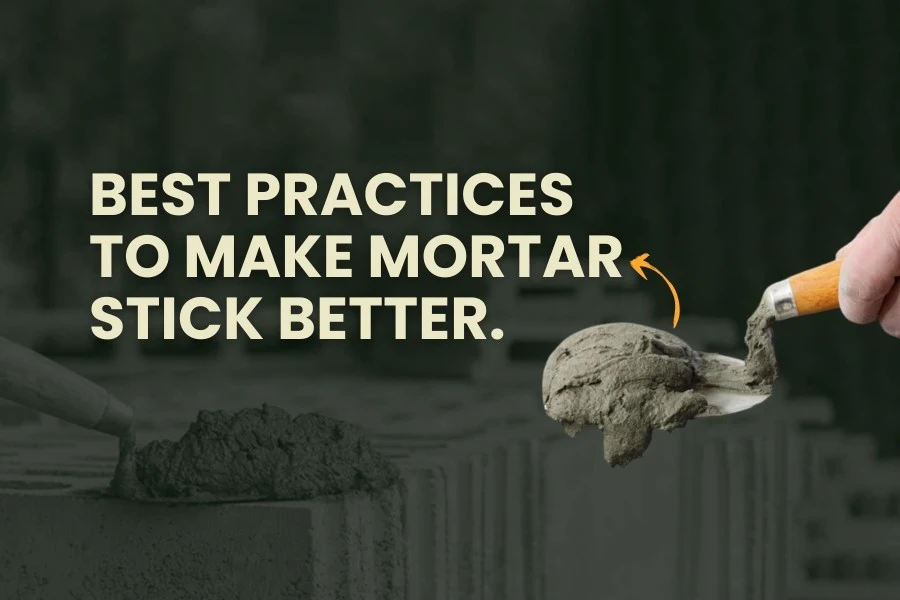Mortar is the silent partner of construction. It holds bricks, locks down tiles, and maintains the integrity of structures for years.
Unfortunately for builders and masons, one of the most common frustrations they face is when mortar doesn’t adhere properly. May it be walls cracking, tiles popping off, or bricks shifting: all can happen when the mortar’s bond isn’t sufficient.
Table of Contents
If you’ve ever found yourself questioning, “How do I get mortar to stick better?”, you’re not alone. Poor mortar adhesion can be caused by sloppy surface prep, improper mixing, or changes in the environment.
The good news is, you can boost adhesion and make your mortar join stronger with a few tips, quality materials, and the right additives.
In this blog, we will cover everything you need to know, from identifying common problems to using contemporary options such as bonding agents or HPMC (Hydroxypropyl Methylcellulose).
At the end of this blog, you will be able to formulate and implement a strategy for creating mortar bonds that resist dislocations!
Why is Mortar Adhesion Important?
Mortar is not just a filler; it is a critical support for masonry. If the
A weak bond will lead to:
- Cracked walls and visible voids.
- Reduced structural integrity.
- Water intrusion and microbial growth.
- Costly repairs and restoration.
Think of mortar as the glue for your project. Just like if you used a weak adhesive to assemble furniture, your project would fall apart if the mortar adhesion is poor. If the mortar is good and made right, the bricks, stones, or tiles will adhere to each other, forming a monolithic or unitary structure.
Common Problems That Will Preclude the Mortar From Sticking
Before we look at how to improve the adhesion of mortar, let us identify the usual suspects that can lead to poor adhesion.
1. Dirty or Oily Surfaces
Mortar will not stick to surfaces that are covered with dust or with oils or greases. It is like painting over a greasy wall, where the paint will quickly peel off. Mortar will do the same thing. It is very important to use a clean surface; otherwise, the bond will remain weak and unreliable.
2. Improper Mortar Mix
This is all about the mix consistency. If the mixture is too dry, the mortar will not adhere to the other materials. On the other hand, if it is too wet, the mortar will sag, allowing no strength. It is important to note that incorrect mix ratios have been shown to cause almost 15% of all construction defects.
3. Dry Base Surfaces
If the base surface is too dry, the base will absorb the water from the mortar too quickly. This rapid absorption causes the mortar to dry rapidly and weakens the bond to create a crumbly and brittle mortar.
4. Extreme Weather Conditions
Mortar adhesion is directly affected by the weather, considering temperature and humidity.
Hot weather = mortar adheres but dries too quickly.
Cold weather = mortar sets too slowly or may freeze, leading to cracks.
5. Overworking the Mortar
By constantly moving the mortar around after you have applied and troweled, you allow the fine particles and free lime to return to the surface. Free lime will always weaken the mechanical bond and can ruin the texture of the mortar.

How to Make Mortar Stick Better?
Now that we know what causes weak adhesion, let’s look at best practices that will result in stronger bonding.
1. Prepare the Surface Properly
When it comes to surface preparation, there is no wiggle room. Scrub off any dust or grease, remove paint or adhesive residues, and eliminate any loose debris. Potential surfacing tools include:
- A stiff-bristle brush.
- A pressure washer.
- Mild detergent, if necessary, to remove stubborn stains.
A slightly rough surface promotes a better mechanical bond. Rougher textures provide more bonding area; sandpaper is the best example of something for paint to hold on to.
Pro Tip: If you’re working on old concrete or plaster surfaces, remove old concrete or plaster from the surface by lightly chiselling or scrubbing to expose fresh material for better adhesion.
2. Use a Bonding Agent
Cleaning alone is sometimes not enough, and this is where bonding agents come in. Bonding agents are liquid chemicals that create a bridge between the substrate and the mortar to produce a stronger chemical bond.
Advantages provided by bonding agents include:
- Better bonding to smooth surfaces (old concrete, glazed tiles, etc.)
- Reduced shrinkage cracks.
- Increased resistance to moisture.
- Extended working time with mortar.
Our bonding agents made from sophisticated polymers at Sakshi Chem Sciences have the ability to stay strong in very harsh applications. For tough scenarios such as tile-on-tile bonding, bonding agents are necessary.


3. Mix to a Mortar That You Like
Mortar consistency is key; the mix should resemble peanut butter—thick, smooth, spreadable, yet firm enough to hold its shape.
General mix ratio:
1 part cement : 3 parts sand (by volume) and include water slowly until the desired consistency is achieved.
A quick check – if the mortar slides off your trowel with too much ease, you may have too much water. If it crumbles, you may have too little water.
4. Use HPMC and Additives to Help in Bonding
Today’s construction chemicals can enhance the performance of mortar systems. One additive we strongly recommend is HPMC (Hydroxypropyl Methylcellulose).

Simply, if the mortar has a quantity of HPMC in it, chances are that it is going to stick better.
Without a doubt, there are reasons why HPMC is great for mortar:
- Retains water and prevents premature drying.
- Extends working open time and allows flexibility.
- Improves workability and smoothness.
- Reduces sag, especially in vertical applications.
- Improves bond strength.
Adding HPMC gives the user assurance that there will be consistent adhesion performance, no matter how bad it gets. This is one of the reasons it’s used in tile adhesives, plaster and repair mortars.
Other useful additives
Lime – increases flexibility and durability
Plasticizers – increase flow and workability
Air-entraining agents – increase freeze-thaw resistance.
5. Wet the Surface Before Application
If a dry substrate draws water from the mortar too fast, the bonds will be weak. Use a light water spray or a damp sponge to pre-wet the surface to ensure good bonding strength.
Here’s how to do it:
Make sure it is moist, not dripping wet
Be careful not to leave puddles of standing water.
The benefits of this simple step are enormous increases in bond strength and a reduction in movement or cracking.
6. Work in Appropriate Weather Conditions
If possible, you should always plan mortar work in moderate weather. However, weather conditions are not always practical or achievable, so here are some things to consider during extremes:
Hot weather:
Use cool mixing water.
Work in early mornings or later evenings.
Cover fresh mortar with wet burlap or curing cloths.
Cold weather:
Warm water and materials slightly for mixing and facilitate a higher temperature cure.
Use frost-resistant additives, slightly warm mixing water, or cement warmers when working in cold conditions.
Protect the work site with temporary insulated enclosures or heaters.
7. Avoid Overworking the Mortar
Always apply/move mortar smoothly, and then leave it alone. If you continually soften, reshape, and push down, you are weakening the structure, leading to poor adhesion.
Think of the mortar as similar to bread dough. If bread dough is constantly kneaded or overworked, it may not get worse as a bread, but it will never get better. Beaten dough has never made the best bread!
8. Allow Proper Curing
Curing is the last step in the process that can really turn your mortar into a great, strong, durable bond. Without sufficient cure, your mortar, no matter how well mixed, the mortar will ultimately fail.
Best curing practices are:
- Keep the surface damp for a minimum of 48 hours.
- Cover with a plastic sheet to encapsulate moisture.
- Avoid direct sun or drying wind during the first curing stage.
Research has shown that concrete or mortar drying too quickly will achieve only about 50% of the strength it could. Properly curing will double their performance.
Advanced Tips for Professionals
Geopolymer Mortars:
Research shows that these materials can be 1.8 times stronger than regular mortars and have up to 7 times the shear strength.
Mechanical Anchoring:
When the project is important and requires added performance, use mechanical anchors along with mortars for more strength.
Quality Control:
Always try a small batch first. Any adhesion tests should be completed on-site to prevent failures on the entire site.
Choose Reliable Additives:
At Sakshi Chem Sciences, we manufacture advanced bonding agents and HPMC-based products to demonstrate increased performance of mortars as required in real-world applications.
Final Thoughts
Having the keen insight into better ways to ensure mortar sticks better is all about working clean, uniformly when applying, and the advancement of mortar through modern technologies.
From cleaning and wetting surfaces to powering up your bonding agents or even looking into HPMCs for water retention, there is so much we can do to achieve better adhesion.
Sakshi Chem Sciences provides over 20 years of combined experience with state-of-the-art R&D in construction chemicals that solve the real-world challenges of your industry.
Our bonding agents, high-performance or otherwise, water-retention products like HPMC, and all-inclusive solutions for mortar availability ensure you have everything you need for attempting whatever task you need.
At the end of the day, strong mortar joints are not just about appearance; they represent trust, reliability, and lasting results..
FAQS
Q1. How do I know if I have the right mortar mix?
Check the consistency. It should be like peanut butter: thick and able to be spread, but also stable. To get it just right, you should always adjust the amount of sand or water accordingly.
Q2. Do you need to add additives to increase adhesion even when using a quality mortar?
Yes. Additives such as bonding agents and HPMC will always increase the grip, help prevent cracking, improve workability, etc.
Q3. What’s the best way to make mortar stick to smooth surfaces?
Use a bonding agent. The bonding agent functions like glue as it ensures the mortar sticks to surfaces, even on challenging substrates like old tiles or polished concrete.
Q4. Knowing what you now know, how long should mortar cure before painting or tiling?
You should allow for a minimum of 48-72 hours for proper curing. Ideally, allow a full 7 days of curing for heavy loads.
Sagar Telrandhe is a Construction Engineer with a B.Tech in Construction Engineering & Management. Passionate about infrastructure development, project planning, and sustainable construction, he specializes in modern construction techniques, project execution, and quality management, contributing to efficient and innovative building.


